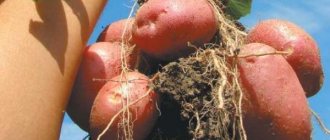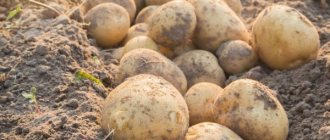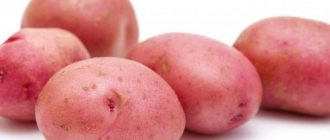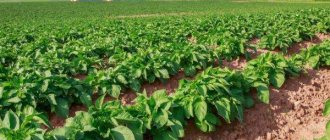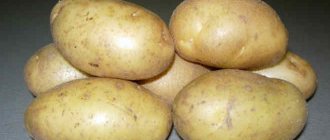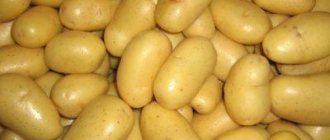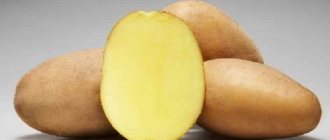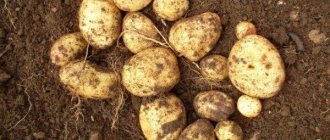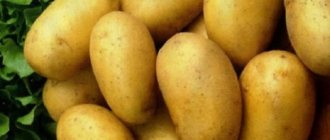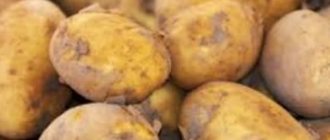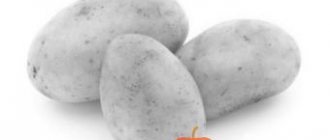What kind of potato is this?
American is an old potato variety, bred in 1861. Its creator is the American breeder Albert Bresee.
In 1931, the variety was included in the Russian State Register. At that time, it was actively grown on collective and state farms in Moscow, Ukraine and all countries of the USSR.
The American is also known under the names : Early Rose, Latvian, Dovzhik, Olkhovka, Skorospelka, Yanovka, Turka, Monthly.
Distinctive features
The peculiarity of American is its excellent taste characteristics . This variety is recognized as the standard of potato taste. It has tender, slightly sweet and crumbly flesh. It does not fall apart when cooked, but at the same time it produces a tasty and airy puree.
Despite the fact that this variety is about 150 years old, its yield exceeds that of many others. One plant produces up to 15 large tubers .
The appearance of the root crop is also attractive. The potato has an oblong, flattened shape , thin light pink skin. The variety is early ripening. The first potatoes are ready for harvest in July.
A negative feature of the American woman is considered to be low immunity. This variety is resistant to many nightshade diseases, but is susceptible to late blight and bacterial canker .
Care
Watering
There are rarely any difficulties with watering potatoes. Typically, no more than 3 to 5 waterings are required during the growing season, depending on the amount of precipitation. If they occur frequently, it is not necessary to supply the potatoes with water. One plant uses 3 liters of water.
Try to water the potatoes at the roots and best in the evening.
Loosening, weeding and hilling
In order for the sprouts to sprout quickly and easily, it is necessary to keep the soil loose. After rains, a crust usually forms on the soil surface, which is very difficult to break through. Therefore, periodic loosening at first is especially important for potatoes. No less important is weeding weeds, which can steal moisture and nutrients from young bushes, and in addition, they are often carriers of various diseases and serve as temporary shelter for many harmful insects.
Hilling of potatoes is carried out twice. The first time this happens when the plants reach a height of about 12 cm, and the second time after three weeks.
Top dressing (table)
Fertilized potatoes grow faster and produce larger tubers. Therefore, do not miss the opportunity to please your plantings with nutrient mixtures.
| Feeding time | Compound |
| Bushes reach a height of 12 cm | After precipitation or watering, add urea (1 tbsp per 10 l) - 0.5 l per bush |
| Flower buds form | Wood ash (2 tbsp.) and potassium sulfate (1 tbsp.) per 10 l - 0.5 l per bush |
| During the flowering period | Mullein (1 cup) and superphosphate (2 tbsp) per 10 l - 0.5 l per bush |
Features of cultivation
Potatoes need to be watered correctly.
From May to August, watering should be done in the early morning hours, or even better, in the evening. In this case, the tops will have time to dry before the sun comes into full force. Otherwise, you risk seeing it scorched by the sun's rays. In August, when the nights become cold, evening watering can cause harm in the form of late blight. Therefore, the only possible time for watering is early morning. Straw is a good mulch option for potatoes: it creates coolness at the roots, and over time it becomes fertilizer
To ensure that water stays at the roots longer and a crust does not form on the surface of the earth, it is useful to mulch the rows and row-spacings with straw, rotted sawdust or mowed plants used as green manure. Mulch gives coolness to the roots, and soon, rotting, it itself becomes a good fertilizer.
Video: growing potatoes under straw
General characteristics of the plant
American is still the most popular potato variety . Due to its high taste characteristics and excellent yields, many gardeners prefer it to many more modern options.
Description of the variety is presented in the table:
| Parameter | Index |
| Ground part of the plant | Medium-sized bush (up to 70 cm). Abundantly leafy. The stems are powerful with a purple (anthocyanin) tint. The leaves are thin, small in size, slightly dissected. Inflorescences are semi-spreading. Short peduncles and pedicels are purple in color. The calyxes are well pubescent, leaf-shaped tips, anthocyanin in color. The corollas are white and small in size. Berries are formed extremely rarely. |
| Roots | Medium size. One tuber weighs from 80 to 150 g. Elongated oval shape, aligned, flattened on both sides. The skin color is light pink with brighter spots. There are many eyes, but they rather resemble pigmentation, since they do not grow into the flesh. The flesh is white, in some cases there are purple spots. The taste is rich, slightly sweet. During heat treatment it becomes crumbly and does not change color. Starch content - up to 17.5%. The sprouts are red or purple. |
| Ripening time | Early ripening. It takes 70–80 days from sowing the root crop to harvesting. |
| Productivity | High. Up to 40 tons are collected from 1 hectare. One bush produces from 5 to 15 tubers. |
| Transportability | High. Tubers can be stored for up to a year without losing their taste. This figure is equivalent to 97%. |
| Immunity to disease | Is immune to most nightshade diseases. There is a possibility of late blight and bacterial cancer. |
| Features of cultivation | Recommended for cultivation in the central and southern parts of the country (Voronezh, Belgorod, Kursk, Moscow regions, etc.). |
Peculiarities
Characteristic features of the variety:
- It is a table variety with medium ripening periods. The growing season ranges from 70 to 80 days;
- The amount of harvest is determined by the nutritional value of the soil and climatic conditions. The yield is 200 centners per hectare;
- To save seed material, propagation in separate segments with sprouts is allowed;
- The seed material does not degenerate.
REFERENCE: Frequent fertilizing and watering increase the yield up to 400 centners per hectare.
Agricultural technology American
Potatoes are grown using the seedless method . Tubers are planted immediately in open ground. In cool regions, the crop is first grown under film.
In the southern regions, potatoes are sown in the ground in early April. In cities with a temperate climate - in the second half.
Advice! Planting material is prepared a month before it is placed in the ground.
Preparation of planting material
To speed up the emergence of seedlings and protect plants from diseases and negative environmental factors, planting material is prepared in advance .
This procedure consists of several stages:
- For planting, select tubers without damage. They should be the size of a chicken egg. Selected root vegetables are left at room temperature for 3 days.
- After this they are disinfected. Wash with a solution prepared from 1 tsp. copper sulfate and 3 liters of water. Then the planting material is dried for 5 days.
- The potatoes are washed in a solution prepared from 3 liters of water and half a teaspoon of boric acid. The tubers are left to dry for 5 days.
- To stimulate growth, planting material is washed in “Solution” or “Superagro”. To prepare it, 1 tsp. The drug is added to 3 liters of water. The tubers are dried again for 5 days.
Other potato varieties:
Consistently productive potato variety Impala
Potatoes "Crimean Rose" for hot climates
Early table potato variety "Tiras"
Then the potatoes are stored for a month at a temperature of +17°C . The room is ventilated daily, and the tubers are sprayed with water at room temperature from a spray bottle.
When many sprouts form on the tubers (after a month), they are placed in a room with a temperature of +10°C for 2 days. After this they are ready to disembark.
Advice! To save planting material, some gardeners cut the sprouted tubers into several parts. If you do this, make sure there are sprouts on each piece.
Soil preparation and planting potatoes
Potato beds begin to be prepared in the fall. Choose a plot of the garden that is in full sun. No other nightshade crops should grow on it for the past 2 years. They are not planted near potato beds either.
In autumn, the soil is dug up to a depth of at least 20 cm . Then they level it with a rake and remove all the larvae from it.
Fertilizers are applied to the beds. 6 kg of cow dung or humus is scattered on each square meter. If the acidity of the soil is increased, scatter 1 tbsp. dry lime per 1 m². Fertilizers are thoroughly mixed with the soil.
Advice! After harvesting in August or September, it is recommended to sow in an area where potatoes, legumes, oats or rye will be grown. This will increase the nutritional value of the soil.
In the spring, the beds are dug up again . They are cleared of weeds and watered with copper sulfate. Apply 3 tbsp per 1 m². l. superphosphate and 1 tbsp. l. potassium sulfate.
Holes 10 cm deep are dug in rows in a checkerboard pattern. The distance between the rows should be 35 cm, and between the recesses - 60 cm.
A handful of ash and onion peels are poured into each hole. Many gardeners also send long-acting complex mineral fertilizers there.
Place 1 tuber in each hole. They are covered with earth without compacting it. The beds are watered with warm water.
Basic rules of care
Before the first shoots appear, the potato beds are loosened 2 times , removing all weeds. As a result, the earthen crust is destroyed, which prevents the tubers from rotting.
Potato beds are watered as the soil dries . Use settled warm water. After each watering and rainfall, the soil is loosened. This is done carefully so as not to damage the tubers, thereby increasing the risk of infection. During the loosening process, the beds are cleared of weeds.
Potatoes are hilled twice during the season . The first time is when the bushes reach a height of 20 cm, and repeat after 2-3 weeks. This promotes the formation of new roots and an increase in the number of tubers.
Advice! After heavy rains, additional loosening will be required.
During the entire period of growing potatoes, they are fed three times according to the following scheme :
- The first fertilizing is applied 2 weeks after emergence. To do this, use a product prepared from 10 liters of water and 1 kg of chicken droppings or rotted cow manure.
- After the formation of the first bud, fertilizer is applied a second time. To do this, prepare a remedy from 1 tbsp. wood ash and 1 bucket of water.
- The last time the plants are fed is during the period of mass flowering. To do this, pour 0.5 liters of a solution prepared from 10 liters of water, 2 tbsp. mullein and 2 tbsp. l superphosphate.
Important! Before each application of fertilizer, the beds are watered with clean warm water.
Tips from gardeners
To avoid problems when growing potatoes, use the advice of experienced gardeners :
- Agree with your neighbors to process and collect the Colorado potato beetle from all nightshade plants on the same day. In this case, a repeated “invasion” of insects will not happen.
- Water and feed potatoes early in the morning or at sunset. If you do this when the sun is active, the tubers will simply “cook” in the soil.
- American bushes grow strongly, which increases the risk of plant infection with late blight. Remove a few leaves from the bottom of the bush.
- To get the largest possible tubers, it is recommended to apply foliar fertilizing 10 days before harvest. To do this, the bushes are simply sprayed with superphosphate.
- Mulch potato beds and soil between rows. This will protect the plants from diseases, pests and negative environmental factors.
- To provide the potatoes with optimal moisture, they are watered not manually, but using an automatic drip method.
- Mark the healthiest and most beautiful bushes with ribbons. It is from them that it is better to collect seed material.
Diseases and pests
American potatoes are resistant to most nightshade diseases , but some infections pose a danger to them:
- Late blight. The stems and leaves become covered with brown spots, which turn black over time and cause the plants to wither. The disease spreads to tubers, leading to their rotting. For prevention, potato bushes are sprayed with a solution of copper sulfate 2-3 times during the entire growing period. The disease cannot be treated; affected plants are removed and burned, and the soil is disinfected.
- Bacterial cancer . Dark formations resembling cauliflower grow from the eyes of potato roots. Such tubers are inedible. The disease cannot be treated. Affected plants are removed, and the soil on which they grew is disinfected.
Prevention will help you avoid contracting these dangerous diseases . It consists of disinfecting garden tools, soil and tubers, observing the rules of watering, hilling, and crop rotation.
Potatoes are often attacked by the Colorado potato beetle . Pests are simply collected from plants by hand. If there are a lot of them, then use chemicals, for example, “Barrier”.
Wireworm attacks potato tubers. It will not be possible to notice and neutralize it in a timely manner. In this case, prevention is important. It consists of mulching, using slightly acidic soils and planting onions between rows of potatoes.
Planting potatoes
For American, you need to choose a well-lit area with light sandy soil. A prerequisite is that there should be no stagnation of water.
If next year you plan to plant the crop in the same place, then in August-September after harvesting, the bed should be sown with green manure: oilseed radish, mustard, legumes, oats. At the first frost, these plants will die, and in the spring they will turn into an excellent fertilizer for the soil.
Green manure plants will be a good fertilizer for the soil
To fertilize the soil in the spring, mullein or horse manure is used, which is evenly spread over the garden bed, after which the soil is dug up.
The best predecessors for potatoes are: legumes, cabbage, pumpkins, cucumbers, garlic, and herbs. The crop cannot be planted in a place where nightshades (tomatoes, eggplant) grew last year.
Preparation of planting material
American tubers are prepared three weeks before planting as follows:
- They take them out of the cellar or other storage place and sort them out, leaving only healthy fruits for planting, the size of an average chicken egg.
- Long white sprouts should be broken off - they are weak.
Long sprouts break off because they have no strength
- At a temperature not lower than 20ºС, the tubers are left to lie for several days to warm up.
- The potatoes are then transferred to a cooler room where there is no direct sunlight. The fruits are laid out in one row.
- Once every few days, the tubers must be sprayed with cool water from a spray bottle. If the room has poor ventilation, it should be ventilated daily to prevent the tubers from rotting.
In a cool room, strong shoots appear on the tubers
Preparing potatoes for planting - video
Boarding pattern and time
When the spring frosts have passed and strong sprouts have appeared on the Americana tubers, you can begin planting. Many gardeners first treat potatoes with fungicidal preparations according to the instructions. Next, the tubers are carefully placed in a box and taken to the planting site.
Potatoes are planted when the threat of return frosts has passed.
Potato tubers grow wide in the soil rather than deep, so it is necessary to provide them with room to grow. The most acceptable planting pattern is 40 cm between bushes and 60 cm between rows. The holes are dug individually or a continuous furrow up to 10 cm deep is created, potatoes are laid out in them, and sprinkled with earth.
The depth of the hole for potatoes is about 10 cm
The optimal planting time for American for the middle zone is the end of April or the beginning of May.
A good result can be obtained by planting potatoes in early April, covering them with film or agrofibre overnight.
Film or agrofibre will protect the shoots from frost
Collection, storage and use of crops
The American potato harvest is already harvested in July . The fact that the root crops have reached their maximum size and are ready for harvesting will be indicated by the withered and yellowed ground part of the bush:
- It is recommended to dig up potato tubers not with a shovel, but with a pitchfork. This will reduce the amount of damage. Harvest only in dry weather.
- To separate the tops from the root crops, just shake them.
- The collected potatoes are laid out on newspaper and dried for 2-3 days. After this, the soil can be easily removed with a dry cloth.
- The tubers are sorted and carefully examined. Damaged copies cannot be stored. They need to be eaten first.
- Potato storage boxes are wiped with copper sulfate or a dark pink solution of potassium permanganate. The room is fumigated with sulfur.
- American is stored in a room with a humidity of no higher than 80% and a temperature of up to +5°C.
- During storage, the tubers are periodically sorted. Damaged copies must be removed.
American is a universal variety . It is suitable for boiling and frying. Some housewives claim that such root vegetables taste better when boiled or baked.
Description of the variety
They first learned about the variety back in the 60s of the 19th century, and then it was not called American, but was called Early Rose. Later, he gained a popular name due to the fact that he appeared in America. In general, the variety has many names - Olkhovka, Turka, Latyshka and others.
American potatoes are characterized by long tubers with a high starch content
This early-ripening variety forms semi-spreading bushes with medium-sized leaves. Blooms with white flowers. It has an interesting feature - it almost does not form berries. The tubers are pink in color, long in shape, have many eyes and are covered with smooth thin skin. The color of the pulp is from light yellow to white. The pulp itself contains a lot of starch.
From the first shoots of the American plant to the full technical ripeness of the tubers, 70 - 80 days pass. Harvest in late July - early August. The weight of one potato is about 100 - 110 grams. On average, one plant produces up to 6 - 10 tubers. From one hundred square meters it is possible to collect up to 4 quintals.
Advantages and disadvantages (table)
| Advantages | Flaws |
| The tubers have an excellent taste and are so juicy that you can squeeze excellent juice out of them. | The keeping quality of tubers of this variety is not at the highest level. |
| The early ripeness of the variety allows you to harvest the first tubers already in July. | The variety is not resistant to typical potato diseases: cancer, late blight and various viral forms. |
| Due to the good germination of all eyes at once, the tubers can be divided into parts to increase the quantity and quality of planting material. |
Advantages and disadvantages of the variety
Benefits of American Potatoes:
- high productivity;
- great taste;
- resistance to many diseases;
- ease of care;
- high shelf life and transportability;
- tubers do not degenerate for 20 years;
- early ripeness.
Among the disadvantages:
- lack of immunity to late blight and bacterial cancer;
- abundant green mass that attracts pests.
Diseases and pests
American potatoes are not affected by many dangerous diseases:
- Viruses;
- Potato cancer;
- Common scab.
The variety is susceptible to late blight. As a preventive measure, bushes are treated with copper-containing preparations. Mulching the soil with straw or mowed grass will help prevent blackleg.
In the middle zone, potato bushes are affected by aphids, spider mites, and Colorado potato beetles. Preventive measures against pests:
- Before planting, water the soil with disinfectant compounds and treat the tubers;
- Infected plants need to be treated with insecticides;
- Compliance with crop rotation will protect against wireworm damage. It is better to plant potatoes after meadow grasses, legumes and cabbage.
Farmer reviews
Reviews from gardeners indicate the high quality of Americana fruits .
Many of them grow this variety year after year. Alisa, Moscow : “My mother raised American. I, too, have not changed this variety for many years. Of course, he is not particularly resistant to disease. You have to regularly treat it with copper sulfate. I grow it because of its great taste. Any dish with it turns out simply excellent. I really like the flattened long fruits, just like in the photo. Convenient for stuffing with halves.”
Gleb, Voronezh : “I remember the taste of American from childhood. This is perhaps the most delicious and beautiful pink potato. I would like to grow it at home, but planting material is not easy to find. This year I found it at the grocery market. I planted it, let’s see what happens.”
Reviews from gardeners about American potatoes
The American variety is distinguished by its high starch content. Indeed, very tasty potatoes and well cooked.
William Vladen
https://www.agroxxi.ru/forum/index.php/topic/462-%D0%BD%D0%B5%D0%BE%D0%B1%D1%8B%D1%87%D0%BD%D1 %8B%D0%B9-%D0%BA%D0%B0%D1%80%D1%82%D0%BE%D1%84%D0%B5%D0%BB%D1%8C/
One potato farmer told me this story. He has a plot of 20 acres. He has been growing American in one place for many years. Then I decided to listen to the recommendations about crop rotation and planted them in another place. And instead of the expected increase in yield, I got exactly the opposite. I changed the place again and... the same result. I returned it to the previous state and again got a good harvest. After this, the landing site does not change. And this is within the boundaries of only 20 acres... Perhaps the American has become “accustomed” to the land over the years of cultivation, perhaps there is something in the composition of the land that suits the American.
Kartofanych
https://www.sadiba.com.ua/forum/showthread.php?t=11371
The American variety is resistant to heat. In my opinion - the most delicious. We lost him about 15 years ago, and for many years now I have been trying unsuccessfully to find him.
HVAC
https://otvet.mail.ru/question/62872630
American potatoes, despite their long history, are still cultivated in garden plots because they have many excellent qualities that gardeners value in this crop. Take the time to find planting material of this variety, and you will soon see for yourself that this is one of the best potato varieties in the entire history of its cultivation.
- Author: Evgeny Udaltsov
I love nature and the beauty of the world around me, I highlight this in my articles and try to help bring beauty to life. Rate this article:
- 5
- 4
- 3
- 2
- 1
(0 votes, average: 0 out of 5)
Share with your friends!
Comparison table with other species
| Variety | Tuber weight | Productivity per 1 ha | Starch content |
| American | 100-110 g | 250-420 c | 15 % |
| Cardinal | 65-110 g | up to 300 c | 14-16 % |
| Bullfinch | 60-90 g | 180-270 c | 16 % |
| Rosara | 80-115 g | 350-400 c | 12-16 % |
| Kamensky | 110-130 g | 500-550 c | 16-18 % |
| Molly | 110-150 g | 390-450 c | 13-22 % |
| Luck | 110 – 150 g | up to 430 c | 11-15 % |
Important!
As you can see, Early Rose has good performance. Potatoes are valued for their fairly large tubers, low starch content, and rich harvest.
